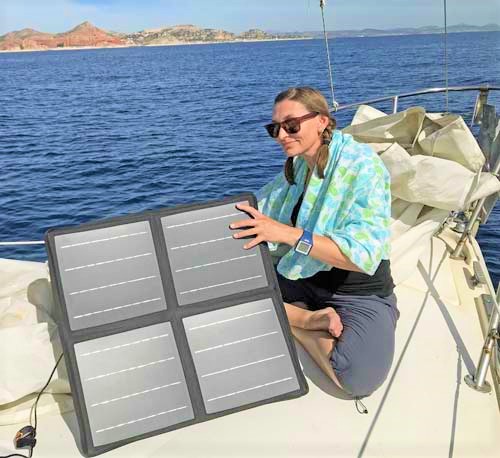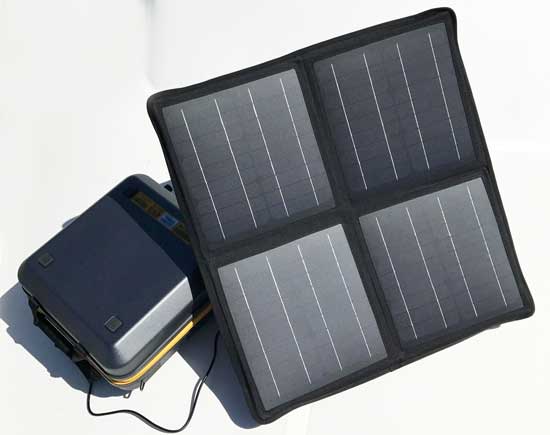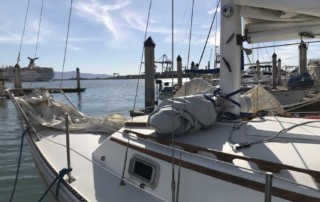written by Captain Ray Roberts
updated: 1-7-2020
Show up with your own power supply. . . then use the sun to re-charge.
My name is Captain Roberts and I’m a long-distance sailor.
I sail offshore for weeks at a time. These trips are only possible with a steady power supply on board.
Portable solar power generators are a brilliant way to compliment a traditional DC battery bank on a boat.
The generators I review on this page also work well for disaster relief and any other “off the grid” scenario (back-country cabin, RV, trailer, zombie apocalypse…)
I’ve written many articles about off-the-grid electrical systems. For this article, I’m reviewing the most reliable solar generators on the market in 2020.
I made sure to include options for a range of budgets and different electrical needs.

My girlfriend secures the solar panels to the bow of our boat. We keep the portable, lithium battery suitcase safe and dry inside. We run the connecting wire through our forward hatch.
Cabo San Lucas in the background. We used this system when we sailed around Baja California on our 30 foot sailboat.
Traditional generators are noisy and run on gasoline. This can be okay, however, you need a constant supply of gasoline. You also need to transport large, flammable gas containers.
Various companies now sell solar powered generators. The generators discussed below contain internal batteries, which can be charged from portable solar panels and from traditional wall outlets in your home.
Most people charge the batteries before they leave home, then use the solar panels to top off their batteries once they’re off the grid. That’s what I do on long boat trips.
Whenever my battery charge dips below 50%, I lay the solar panels out in the sunshine.

Here’s a 40-watt portable solar panel charging a portable 384 watt/hr lithium ion battery.
I use this system on the boat to charge phones, lap-tops, cameras and a hand-held GPS.
When necessary, the battery is also used to run a 10 watt floodlight, a large fan and a flat screen TV/DVD player.
In the table below, I list the 8 most reliable solar generators on the market in 2020.
I combine multiple inputs to arrive at this list (customer feedback, durability, pricing, input/output features, solar panel compatibility, brand reputation, ext.)
I cover the range of solar powered scenarios – starting with a small, rechargeable flashlight and ending with the generator that helped power disaster relief efforts after Hurricane Harvey.
The most affordable options are at the top. Click on the product name to learn more.
All of these products are good. If you think I’m wrong or have had a bad experience with one of these generators, then please let me know. If I hear enough negative feedback, I’ll remove a generator from the list.
Below the table, I include my thoughts and opinions on my personal favorites from the list.
If viewing on a phone, scroll right on the table to see all content.
Stay safe out there!
| Brand / model | Battery type | Weight (lbs.) | General uses | Power supply | Price |
|---|---|---|---|---|---|
| Esky Solar Hand Crank |
Ni/MH | .6 | Built-in LED light/radio,
charges phones |
1 Amp/hr | $18 |
| SUAOKI 222 |
Lithium ion | 5.5 | smartphone, lap-tops
mini-fridge, small appliances |
20 Amp/hr
222 Watt/hr |
$199 |
| Goal Zero / Yeti 150 |
sealed lead/acid (AGM) | 12 | phone, lap-top
tablet, lights |
14 Amp/hr
150 Watt/hr |
$199 |
| Renogy / Phoenix |
Lithium ion | 12.8 | phone, tablet
lap-top, lights small/medium appliances power outage emergencies |
246 watt/hr | $358 |
| Goal Zero / Yeti 400 |
lead acid
(lithium also available) |
29 | phone, lap-top
tablet, lights small appliances emergency back-up |
33 Amp/hr
396 Watt/hr |
$449 |
| Anker / PowerHouse |
Lithium ion | 9.2 | lap-tops, phone
small/medium appliances |
120 Amp/hr
400 Watt/hr |
$499 |
| Inergy Apex |
Lithium ion | 25 | medium/large appliances
CPAP machine, |
1100 Watt/hr | $1199 |
| Goal Zero Yeti 1400 |
Lithium ion | 43.7 | similar to Yeti 400, but suited for
large appliances, fridge, disaster relief |
396 Amp/hr
1425 Watt/hour |
$1899 |
Click an icon below to share page with friends.
Now for my personal opinions on these generators….
I included a very cheap rechargeable flashlight at the top of the list. While this item is stretching the definition of a generator, they do have built-in solar panels that re-charge an internal battery. The Esky includes a hand crank as an alternative option to keep a charge on the battery. This is helpful on cloudy days. For under 20$, it’s a smart resource to include in an emergency throw bag or in the trunk of your car.
The other 7 options on the list are more traditional solar powered generators.
In general, the price of these generators increases as the power output increases. I included a collection of quality options that range in power output from 150 – 1425 Watt/hours.
I update this list each year and only include models that receive overwhelmingly positive customer feedback on various forums and tech websites.
That said, I do have my favorites…
In the medium size range, I like the Goal Zero 400 and the Anker PowerHouse
. I’ve used both on long sailing trips out to the northern Channel Islands. They both deliver in the 400 Watt/hr range. They’re both priced just under $500. Last time I compared the price of Anker vs Yeti, the Yeti 400 was about $50 cheaper.
Goal Zero Yeti 400 vs Anker powerhouse
Both companies are known for quality batteries. At time of writing, Goal Zero did not have any lithium versions in stock, therefore the Yeti 400 listed in my table is the lead acid version.
In terms of power supply to weight ratio, the Anker powerhouse wins at only 9 pounds. If you’re contemplating backpacking a generator into the woods, weight becomes an important metric. If the extra 20 pounds is not an issue, I would pick up the cheaper Yeti 400 lead acid battery. Also, lead acid does have some benefits over lithium. This page helps you weigh pros and cons of lithium vs. lead acid.
The Goal Zero, Anker and Inergy generators are sold as separate units from their respective solar panels. These generators are designed to receive a power supply from solar panels, but you need to purchase the panels separately. If you don’t want to deal with choosing/installing panels, then I would point you to the Renogy Phoenix.
The Renogy Phoenix is my preferred ‘all-in-one’ portable solar powered generator. I recently used this unit on a 20-day road trip down the Baja peninsula. It’s packaged in a rugged, black suitcase design. When you open this 12 pound suitcase, you see that one side holds the fold-able 20 watt panel, while the other side houses the lithium ion battery. Rated at 246 Watt/hours, this unit delivers a lot of power to keep many devices topped off for many days.
Inergy Apex vs Goal Zero Yeti
Both the Goal Zero Yeti 1400 and the Inergy deliver large amounts of power. Goal zero 1400 offers 1425/watt hours while Inergy Apex delivers 1100/watt hours. These are the numbers you should be considering when powering mid-size and large appliances. Both of these items are sold without solar panels, however you can easily determine the appropriate panels for each battery (read product details on their respective Amazon page.)
People often store these generators in their basement to safeguard against a power outage. They’re both high quality, but I prefer the Goal Zero Yeti 1400. It weighs more than the Apex, but I’ve heard more positive feedback about the Goal Zero vs Inergy. Many readers reach out to let me know they love their Yeti 1400 for the charge quality of the battery.
Frequently asked questions
FAQ: How much power do these different generators provide?
Our table lists electrical output in terms of Watt/hours and Amp/hours. These values inform you how much power the internal battery can provide and for how long. Watts and Amperage are different ways to measure how much electricity is needed to power a device.
For example, here are a few simple examples to help understand Watt/hours.
- a 200 Watt/hour generator could power a 200 Watt light for 1 hour (200/200 = 1 hour)
- or a 200 Watt/hour generator could run a 100 Watt light for 2 hours (200/100 = 2 hours)
- or a 200 Watt/hour generator could run a 20 Watt light for 10 hours (200/20 = 10 hours)
Each chargeable device should list either the Watt/hours or Amp/hours required to fully charge the device. For example, the average smart phone requires 5 Watt/hours to fully charge. Therefore, a 200 Watt/hour generator would be able to charge that phone 40 times.
If you would like a more thorough analysis of this subject, you can learn more here.
FAQ: Are solar panels included with these generator?
Some generators come packaged with the appropriate solar panels, others do not.
The Renogy/Phoenix generator is designed as a rugged suitcase that includes two 10 Watt panels. The user then has the option of installing additional panels to provide up to 120 Watts total.
All of the other generators (aside from the flashlights) do not include their solar panels with the generator unit. If the generator does not come packaged with solar panels, the manufacturer clearly lists the recommended panels.
You generally have the option of purchasing one panel or multiple panels. Most of these generators have solar panel input ports to accommodate multiple panels. As you’d expect, when you increase the total wattage of your solar panel array, you will shorten the sunlight time required to fully charge the battery inside your generator.
FAQ: What type of devices can I charge with these generators?
Each of the 8 larger generators have 3 options in terms of using the electricity stored on the internal battery.
- a USB port (charge a cell phone, lap-top or tablet)
- a DC port (a source of DC electricity… similar to your car’s cigarette lighter)
- a regular 110 AC port (same outlet found in your home, plug in your household appliances)
FAQ: How long does it take to charge the batteries on these generators?
Each generator will differ in charging times. But that said, we can provide some general information.
In general, charging your generator from a wall port in your home (110V AC) will be 2-3 times faster than charging from a solar panel. Keep in mind, larger solar panels will charge your generator much faster than smaller panels. To illustrate this – here’s an example.
If you’re using the Goal Zero 400:
- charging from home will top off the generator battery in 5 hours
- charging from a large solar panel (90 watt) will top off the generator battery in 9-18 hours
- charging from a small solar panel (20 watt) will top off the generator battery in 40-80 hours
The takeaway…if you plan to use the sun to re-charge your generator on a regular basis, make sure you invest in a larger panel. In a future articles, I will provide review that is specific to the question of the best boat generator. Stay tuned!
Also, here are are some common sense tips to help ensure you’re getting the most power from the sun.
If you are a boater and are considering placing solar panels on your boat. I wrote up this ‘Do-it-yourself’ tutorial describing how to install solar power on your boat. This set-up feeds electricity directly onto a boat’s DC battery bank.
I’m a long time sailor and I firmly believe all boats should have a panel mounted somewhere. It’s a great way to ensure you always have a charge on board.
Alright…that’s the end of our review of portable solar power generators.
We hope our 2020 comparison provided a few ideas and helped you start the process of becoming energy independent.
Need some comic relief after all that energy discussion? Here’s Captain Ray’s all-time, favorite sea-faring joke. Enjoy!
Disclaimer:
We do our best to ensure the information on allthingsboat.com is accurate and updated at all times, however, we are unable to guarantee the accuracy of all information. Efforts have been made to keep the content up to date and factual. However, these product details will change year to year. For example on our section detailing the comparison between inergy apex vs goal zero yeti, it is possible the exact weight values may change as the manufacturers modify the units each year. A unit that I consider to be the best boat generator may fall short on certain important metrics for land use. I did my best to optimally compare the goal zero vs anker systems. For the most current and complete information, please visit the website of each solar generator manufacturer.
Some of the links on this page are affiliate links. Click here for more affiliate information. This means I may receive a small commission for any purchase made. This fee will not add to the cost on your end but it will help me fund this website and keep it updated. Thanks for visiting!






